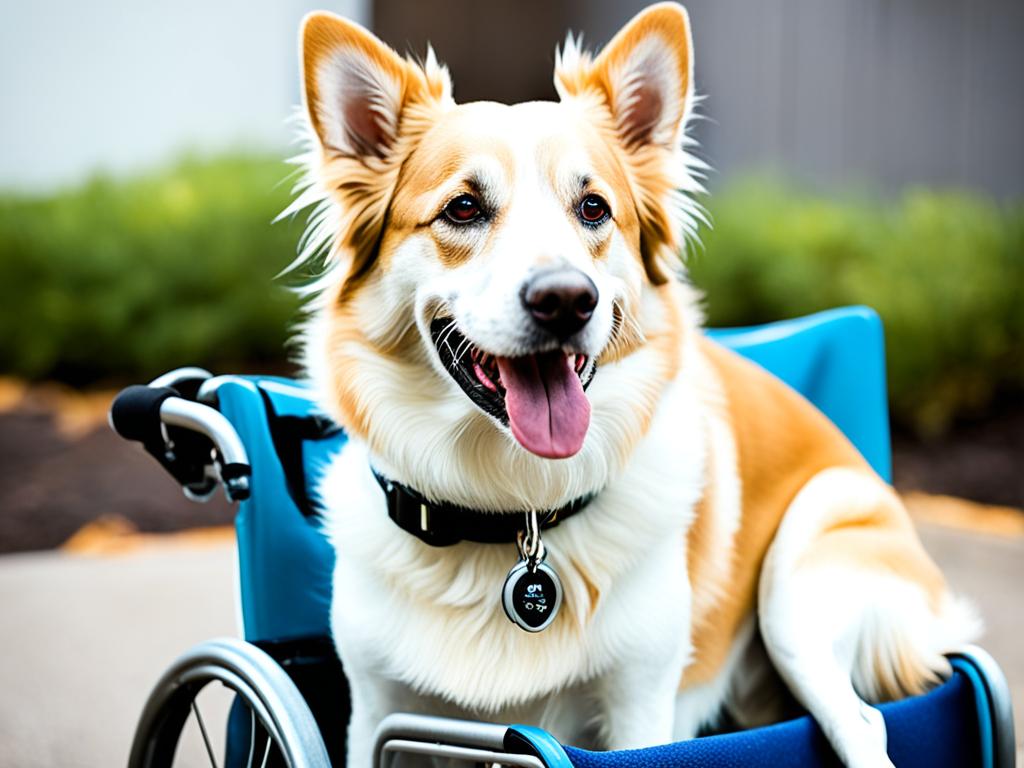
Did you know that there are millions of disabled dogs in need of loving homes worldwide? These incredible animals have unique challenges, but they also possess a resilient spirit and limitless love to offer. However, before embarking on the journey of adopting a disabled dog, it’s crucial to understand the ethical considerations involved to ensure their well-being and happiness.
Key Takeaways: Adopting a Disabled Dog?
- Adopting a disabled dog requires careful thought and consideration
- Ethical considerations include veterinary care, home modifications, introduction to children and other pets, training, and the benefits of the human-animal relationship
- Providing necessary veterinary care for a disabled dog is a financial commitment
- Home modifications can enhance the safety and comfort of a disabled dog
- Introducing a disabled dog to children and other pets should be done gradually and with patience
Veterinary Concerns and Expenses
When considering the adoption of a disabled dog, it’s essential to understand the veterinary care and expenses that may be involved. According to veterinarian Dr. Jeff Werber, the general veterinary care for a blind dog is not significantly different from that of a sighted dog. Regular check-ups, vaccinations, and preventive treatments such as flea and tick control are necessary for both. However, it’s important to note that in cases where a dog’s blindness is caused by an underlying disease, such as glaucoma, there may be additional expenses for medication or surgery to manage the condition.
It is crucial for potential adopters to factor in the financial commitment required to provide necessary veterinary care for a disabled dog. While routine veterinary care expenses are similar to those for any dog, it is important to consider the potential costs of managing and treating any underlying conditions associated with the dog’s disability. This includes ongoing medication, specialized treatments, and regular check-ups to monitor their health and well-being.
Adopting a disabled dog can be a fulfilling and rewarding experience, but it’s vital to be prepared for the financial responsibilities that come with it. By understanding the potential veterinary care expenses and including them in your budget, you can provide the necessary care and ensure the best quality of life for your furry companion.
| Veterinary Expenses for a Disabled Dog | Average Cost |
|---|---|
| Veterinary Check-ups | $50 – $100 per visit |
| Vaccinations | $15 – $45 per vaccine |
| Medication | $20 – $200 per month |
| Surgical Procedures | Varies based on the procedure and underlying condition |
| Specialized Treatments | Varies based on the treatment required |
| Emergency Care | Varies based on the nature of the emergency |
Home Modifications for a Disabled Dog
While blind dogs are remarkably adept at adapting to their surroundings, making certain home modifications can greatly enhance their safety and comfort. By implementing some simple changes, pet owners can create a living space that accommodates the unique needs of their disabled dogs.
Simple furniture layouts: Ensuring clear pathways throughout the house is essential for blind dogs to navigate comfortably. By arranging furniture in a way that provides unobstructed paths, pet owners can minimize the risk of their dogs getting stuck or turned around. Clear, open spaces allow blind dogs to navigate safely and confidently.
Pup-proofing the house: Taking steps to secure the home environment is crucial for the safety of a disabled dog. Locking food cupboards prevents access to potentially harmful substances, while blocking off stairs eliminates the risk of falls. Cushioning sharp corners and using baby gates can protect blind dogs from accidental injuries. Additionally, in the yard, hazards such as swimming pools should be properly secured to avoid accidents or injuries.
Assistive devices: Various devices can aid in the mobility of blind dogs and prevent them from hurting themselves on obstacles. Blind dog halos, which are lightweight rings that encircle the dog’s head, act as a protective barrier and offer tactile feedback to prevent collisions. Dog harnesses that come with a handle allow pet owners to guide and support their blind dogs during walks or outdoor activities. Dog wheel chairs aiding the support and mobility.
Essential Home Modifications for a Disabled Dog
| Home Modification | Description |
|---|---|
| Arranging furniture | Creating clear pathways to prevent blind dogs from getting stuck or turned around. |
| Pup-proofing | Securing the house by locking food cupboards, blocking off stairs, and cushioning sharp corners. |
| Yard safety | Puppy-proofing the yard and securing hazards like swimming pools. |
| Assistive devices | Using blind dog halos and dog harnesses to aid in mobility and prevent injuries. |
In addition to the physical modifications, it is important for pet owners to provide ample mental stimulation and enrichment for their disabled dogs. The next section will delve into the importance of training and enrichment activities for blind dogs.
Introducing a Disabled Dog to Children and Other Pets
When welcoming a disabled dog into a household with children, it is crucial to proceed with patience and sensitivity. Children’s quick movements and loud noises may startle or overwhelm the dog, so it’s essential to create a calm and controlled environment for their introduction.
The olfactory sense plays a significant role in a dog’s perception of the world. Therefore, allowing the disabled dog to familiarize themselves with the smell and sound of the children before any physical interaction is highly recommended. Both children and adults should approach the dog slowly, calling their name in a soft tone, and extending a hand for them to sniff. This gradual approach helps establish trust and comfort between the dog and the children.
When the initial introduction is successful, children can be encouraged to interact gently with the dog, using smooth and calm movements. Supervision is crucial in the beginning stages of their relationship to ensure both the dog and the children feel safe and secure.
Similarly, introducing a disabled dog to other pets in the household is usually a smooth process. Animals have a sixth sense and often adapt well to each other’s company. However, it remains important to monitor their interactions closely and introduce them gradually to prevent any signs of stress or discomfort.
Guidelines for Introducing Disabled Dogs to Other Pets:
- Start by allowing the pets to sniff each other’s scent through closed doors or a barrier, such as a baby gate. This helps them become familiar with each other’s presence without direct contact.
- Once the pets have become comfortable with each other’s scent, you can begin supervised face-to-face introductions in a neutral location. Keep the initial interactions short and gradually increase the duration as they grow more comfortable.
- Look for positive body language, such as relaxed postures, wagging tails, and playful behavior, as indicators that the introduction is going well.
- If any signs of tension or aggression arise, separate the pets and consult a professional animal behaviorist for guidance.
| Potential Challenges | Recommended Approaches |
|---|---|
| Children or other pets showing fear or anxiety towards the disabled dog. | Provide education and information about the dog’s disability to help alleviate fear and build empathy. Encourage interactions in a controlled and supervised setting to foster a positive relationship. |
| Disabled dog displaying aggression or fear towards children or other pets. | Consult with a professional dog trainer or behaviorist who specializes in working with disabled dogs. They can assess the situation and provide personalized training techniques to address the specific challenges. |
| Overwhelming excitement or excessive energy during interactions. | Teach children and other pets appropriate ways to engage with the disabled dog, such as gentle play, soft petting, and calm behavior. Establishing consistent routines for exercise and mental stimulation can also help manage their energy levels. |
Remember, each dog’s temperament and personality may vary, so it’s essential to approach introductions with care and sensitivity. With time, patience, and proper guidance, a disabled dog can form loving and harmonious relationships with children and other pets.
Training and Enrichment for a Disabled Dog
Blind dogs, just like sighted dogs, benefit from lifelong training and mental stimulation. Clicker training, which uses a distinct clicking sound and positive reinforcement, is particularly effective for blind dogs. By associating the sound of the clicker with a reward, blind dogs can learn new commands and behaviors. Finding a professional dog trainer who understands progressive, science-based methods and has experience training blind dogs is highly recommended.
Enrichment activities are crucial for the well-being of disabled dogs. Scenting and tracking games allow blind dogs to use their exceptional sense of smell to explore their surroundings and engage with their natural instincts. Body awareness exercises, such as navigating obstacle courses or walking on different textures, can help improve their spatial awareness and confidence. Engaging them with puzzle toys provides mental exercise and stimulates problem-solving abilities.
In addition to physical and mental exercise, holistic treatments like Reiki can also benefit disabled dogs. Reiki, a Japanese healing technique, uses gentle touch to promote relaxation and reduce stress. This can be particularly soothing for blind dogs, who may experience anxiety or fear due to their sensory impairment.














